人体器官名词的隐喻与转喻研究
英汉人体器官名词动用中的转喻思维
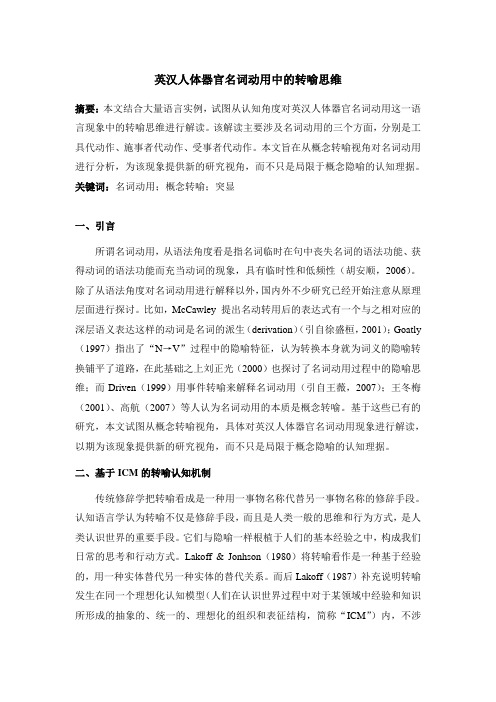
英汉人体器官名词动用中的转喻思维摘要:本文结合大量语言实例,试图从认知角度对英汉人体器官名词动用这一语言现象中的转喻思维进行解读。
该解读主要涉及名词动用的三个方面,分别是工具代动作、施事者代动作、受事者代动作。
本文旨在从概念转喻视角对名词动用进行分析,为该现象提供新的研究视角,而不只是局限于概念隐喻的认知理据。
关键词:名词动用;概念转喻;突显一、引言所谓名词动用,从语法角度看是指名词临时在句中丧失名词的语法功能、获得动词的语法功能而充当动词的现象,具有临时性和低频性(胡安顺,2006)。
除了从语法角度对名词动用进行解释以外,国内外不少研究已经开始注意从原理层面进行探讨。
比如,McCawley 提出名动转用后的表达式有一个与之相对应的深层语义表达这样的动词是名词的派生(derivation)(引自徐盛桓,2001);Goatly (1997)指出了“N→V”过程中的隐喻特征,认为转换本身就为词义的隐喻转换铺平了道路,在此基础之上刘正光(2000)也探讨了名词动用过程中的隐喻思维;而Driven(1999)用事件转喻来解释名词动用(引自王薇,2007);王冬梅(2001)、高航(2007)等人认为名词动用的本质是概念转喻。
基于这些已有的研究,本文试图从概念转喻视角,具体对英汉人体器官名词动用现象进行解读,以期为该现象提供新的研究视角,而不只是局限于概念隐喻的认知理据。
二、基于ICM的转喻认知机制传统修辞学把转喻看成是一种用一事物名称代替另一事物名称的修辞手段。
认知语言学认为转喻不仅是修辞手段,而且是人类一般的思维和行为方式,是人类认识世界的重要手段。
它们与隐喻一样根植于人们的基本经验之中,构成我们日常的思考和行动方式。
Lakoff & Jonhson(1980)将转喻看作是一种基于经验的,用一种实体替代另一种实体的替代关系。
而后Lakoff(1987)补充说明转喻发生在同一个理想化认知模型(人们在认识世界过程中对于某领域中经验和知识所形成的抽象的、统一的、理想化的组织和表征结构,简称“ICM”)内,不涉及跨域映射。
阿拉伯语人体词“眼”一词多义的隐喻和转喻认知研究

阿拉伯语人体词“眼”一词多义的隐喻和转喻认知研究眼睛是人体中最重要的器官之一,它不仅是感知世界的窗口,同时也在各种文化中被赋予了丰富的隐喻和象征意义。
而在阿拉伯语中,人体词“眼”更是具有多义的隐喻和转喻,对于阿拉伯语言和文化的认知研究具有重要意义。
首先我们来看一下阿拉伯语中对于“眼”的多义隐喻和转喻。
在阿拉伯语中,“眼”这个词有多种意义,除了指代人体器官外,还可以表示眼睛的外表、视线和观察等含义。
在阿拉伯文化中,“眼”也常被用作隐喻和转喻的载体,象征着力量、权力、智慧、神秘、独立等多种意义。
在阿拉伯传统文化中,“眼”常常被赋予保护作用的隐喻,比如“恶眼”和“护眼”等概念。
在阿拉伯人的日常生活中,他们相信“恶眼”会带来不祥之兆,因此会采取一系列的防护措施来避免受到“恶眼”的伤害。
“护眼”则被视为一种保护力量,人们相信通过一些护眼的物品或仪式可以保护自己免受不详的灾祸。
除了保护的隐喻意义外,阿拉伯语中的“眼”还有着许多积极的象征意义。
在阿拉伯诗歌和文学作品中,经常可以看到对“眼”富有诗意的描写,比如“明亮的眼睛”常被用来形容智慧和聪明,而“泪眼”则被赋予了感伤和柔情的形象。
在阿拉伯宗教文化中,“眼”也承载着神秘和启示的意义,被视为观察和洞察灵魂的窗口,同时也是对于神秘世界的理解和智慧的象征。
在阿拉伯语中,“眼”这一词语的多义隐喻和转喻反映了阿拉伯文化对于视觉和观察的重视,以及对于眼睛的神秘和力量的崇敬。
通过对于“眼”这一词语的深入研究和解读,可以更好地理解阿拉伯语言和文化中丰富多彩的象征意义和文化内涵。
在认知科学的研究领域中,也有学者对于“眼”这一词语的多义隐喻和转喻进行了认知分析。
通过对于阿拉伯语中“眼”这一词语的认知研究,可以揭示出人们对于视觉和观察的认知模式和心理过程,进而为跨文化认知研究提供重要的参考和依据。
在认知研究中,学者们通过实证研究和实验手段,探讨了不同文化背景下人们对于“眼”这一词语的认知特点和情感表达。
汉英身体名量词的认知聚焦方式
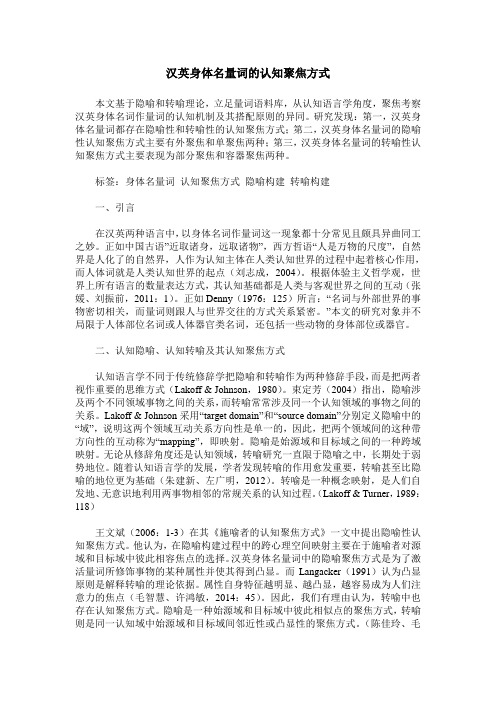
汉英身体名量词的认知聚焦方式本文基于隐喻和转喻理论,立足量词语料库,从认知语言学角度,聚焦考察汉英身体名词作量词的认知机制及其搭配原则的异同。
研究发现:第一,汉英身体名量词都存在隐喻性和转喻性的认知聚焦方式;第二,汉英身体名量词的隐喻性认知聚焦方式主要有外聚焦和单聚焦两种;第三,汉英身体名量词的转喻性认知聚焦方式主要表现为部分聚焦和容器聚焦两种。
标签:身体名量词认知聚焦方式隐喻构建转喻构建一、引言在汉英两种语言中,以身体名词作量词这一现象都十分常见且颇具异曲同工之妙。
正如中国古语”近取诸身,远取诸物”,西方哲语“人是万物的尺度”,自然界是人化了的自然界,人作为认知主体在人类认知世界的过程中起着核心作用,而人体词就是人类认知世界的起点(刘志成,2004)。
根据体验主义哲学观,世界上所有语言的数量表达方式,其认知基础都是人类与客观世界之间的互动(张媛、刘振前,2011:1)。
正如Denny(1976:125)所言:“名词与外部世界的事物密切相关,而量词则跟人与世界交往的方式关系紧密。
”本文的研究对象并不局限于人体部位名词或人体器官类名词,还包括一些动物的身体部位或器官。
二、认知隐喻、认知转喻及其认知聚焦方式认知语言学不同于传统修辞学把隐喻和转喻作为两种修辞手段,而是把两者视作重要的思维方式(Lakoff & Johnson,1980)。
束定芳(2004)指出,隐喻涉及两个不同领域事物之间的关系,而转喻常常涉及同一个认知领域的事物之间的关系。
Lakoff & Johnson采用“target domain”和“source domain”分别定义隐喻中的“域”,说明这两个领域互动关系方向性是单一的,因此,把两个领域间的这种带方向性的互动称为“mapping”,即映射。
隐喻是始源域和目标域之间的一种跨域映射。
无论从修辞角度还是认知领域,转喻研究一直限于隐喻之中,长期处于弱势地位。
随着认知语言学的发展,学者发现转喻的作用愈发重要,转喻甚至比隐喻的地位更为基础(朱建新、左广明,2012)。
9 人体词语词义转喻性研究_黄碧蓉

外语学刊 FOREIGN LANGUAGE RESEARCH
2011 , No. 4 Serial No. 161
人体词语词义转喻性研究
黄碧蓉 于 睿
*
( 上海海洋大学, 上海 201306 / 复旦大学, 上海 200433 ; 哈尔滨工业大学, 哈尔滨 150001 )
On the Metonymical Properties of Acceptation of Body Terms
Huang Birong Yu Rui
( Shanghai Ocean University,Shanghai 201306 ,China / Fudan University,Shanghai 200433 ,China; Harbin Institute of Technology,Harbin 150001 , China) The human body with all its complexities has been applied to help us to know and experience the world for millennia. This has resulted in the strong metaphorical and metonymical properties of acceptation of the body terms. This paper focuses on the latter,and elaborates upon the problem from four aspects, namely the body terms metonymically used for the person, for the units of measurement ,for the physical features or functions possessed by body parts,and for the action of body parts. The convenience of the metonymy makes the metonymical properties of acceptation of the body terms a prominent feature. Therefore,synchronically and diachronically,it deserves more studies. Key words: body terms; acceptation; metonymical properties; prominent feature “作为一种基质 ” “认识和体验世 我们的身体被 用于 ( 万晋红 2009 : 9 - 11 ) , “体认 ” 界” 历经几千年这种 世界 的过程, 表身体各部位的人体词语的意义相应地被赋予 厚重的隐喻性和转喻性 。 因篇幅所限, 本文拟对人体词 语词义的转喻性做专题探讨 , 其隐喻性将另文研究。 认知语言学家在经过大量的研究后发现 , 转喻在一 定程度上比隐喻更为基本 , 是比隐喻更为基本的认知现 象( Panther & Radden 1999 ,Koch 1999 ,Taylor 1989 ,RadBarcelona 2003 ) 。在转喻中, den & Kvecses 1999 , 涉及的 “接近” “突显 ” 是一种 和 的关系, 事物容易理解或容易被 感知的属性或方面被用来代替事物的整体或事物的另外 某一方面或部分( Lakoff 1987 : 77 ) 。 通过对人体词语进行批量考察 , 我们发现其词义的 转喻操作依据邻近性基本涉及以下 4 类情形: 人体部位 — —人相邻近, 与其主体— 继而人体词语用作转指人 ; 与人 们的认识、 实践活动相邻近, 继而人体词语用作转指长度 单位; 与其某一突出特征或功能相邻近 , 继而人体词语用 作转指人体相应部位的特征或功能等 ; 与它相应的动作、 行为等相邻近, 继而人体词语用作转指人体部位相应的 动作行为。下面拟对人体词语的这 4 种转喻操作类型逐 一进行解析, 藉此探讨人体词语词义的转喻性特征 。
从认知角度分析人体名词动用中隐喻和转喻思维
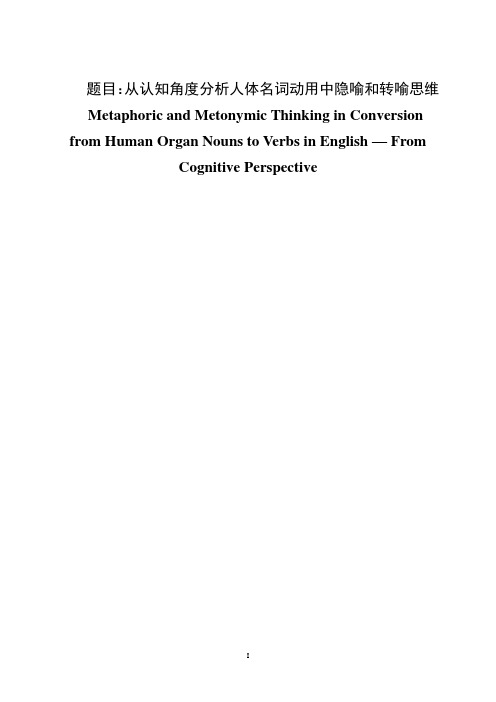
题目:从认知角度分析人体名词动用中隐喻和转喻思维Metaphoric and Metonymic Thinking in Conversion from Human Organ Nouns to Verbs in English — FromCognitive PerspectiveMetaphoric and Metonymic Thinking in Conversion from Human Organ Nouns to Verbs in English — FromCognitive PerspectiveAbstract【ABSTRACT】Under the frame of metaphor and metonymy and from the perspective of cognitive linguistics, the author analyzes this phenomenon and instances of the conversion from human organ nouns to verbs in English. The author analyzes the cognitive dissonances between metaphor and metonymy in the conversion from human organ nouns to verbs. Furthermore, the author will explain the significance of metaphor and metonymy in cognitive linguistics. It is an important tool by which people understand and know the abstract world. In cognitive domain, people consider metaphor and metonymy are not only modification means of language, but also the requirement of people knowing the world. Simultaneously, revealing the guidance function of metaphor and metonymy in the conversion from human organ nouns to verbs. The author hope people understand the essence and differences of metaphor and metonymy.【KEYWORDS】Metaphor; Metonymy; ConversionContents1. Introduction (1)1.1 Necessity of Study (1)1.2 Purpose of Study (1)2.Literature review (2)2.1 Theoretic Background (2)2.2.1 Studies on Metaphor (2)2.1.2 Studies on Metonymy (3)2.2 Conversion from Nouns to V erbs (4)3. Metaphors and Metonymies in the Conversion from Human Organ Nouns to V erbs (5)3.1 Metaphoric Thinking in the Conversion from Human Organ Nouns to V erbs (5)3.1.1 Substituting Specific Things for Abstract Things (6)3.1.2 Lexicological Factors (7)3.1.3 Cultural Factors (7)3.1.4 A Brief Summary (8)3.2 Metonymic Thinking in the Conversion from Human Organ Nouns to V erbs (8)3.2.1 Linguistic Factors (9)3.2.2 Cultural Factors (10)3.2.3 A Brief Summary (10)3.3Cognitive Dissonances (11)4. Conclusion (12)References (14)Acknowledgements (15)1. Introduction1.1 Necessity of StudyMetaphor and metonymy are two linguistic frequent phenomena which appear in English language. Metaphor, according to Lakoff G & Johnson (1980) in Metaphors We Live By, is pervasive in our daily life, happens not only in human’s language but also in human’s thinking and behavior. The utilization of metaphors is very frequent, and practically it is highly valuable to study linguistic metaphor. Metonymy, like metaphor and certain other tropes, is not just a figure of speech, but reflects an important part of the way people ordinarily conceptualize themselves, events, and the everyday world. In recent years, the research of metaphor and metonymy in the conversion in English from nouns to verbs is a very hot topic. It is significant to study the phenomenon of metaphor and metonymy in the conversion from human organ nouns to verbs for the development of English language. Almost all nouns of human organs can be used as verbs. They can be used both as transitive verbs and intransitive verbs. These nouns are very familiar to us. William Shakespeare wrote a sentence some three hundred years ago “Y ou can happy your friend, malice or foot your enemy, or fall an axe on his neck.” Here Shakespeare converted a noun “foot” into a verb with the meaning “kick with your foot”. This makes the expression more vivid and remarkably true to life. This phenomenon is commonly seen in English.In this thesis, several examples of conversion from human organ nouns to verbs will be analyzed. Such as “head”, “hand”, “foot”, “nose”, “face” and so on. Analyze their metaphorical verb form and metonymic thought in some sentences.Metaphor is not only a linguistic phenomenon, but also a cultural phenomenon, a thinking phenomenon and a cognitive phenomenon. Metaphor is the way which reflects people’s mode of thinking. Metonymy grasps the most striking and understandable of an object, a thing or a concept, so it makes the language more vivid and lively.1.2 Purpose of StudyThe hypothesis is that people can understand and accept metonymy better than metaphor. In our mind, forming metonymy goes through only one process. However, there are two or more steps to form a metaphor. However, not all nouns of human organs can be shifted into verbs because the meaning is limited by the original nouns. They are only containing a part of the nouns’ meaning. The study of metaphor and metonymyin the conversion in English from human organ nouns to verbs is a very important and meaningful area. It is helpful for us to comprehend a linguistics phenomenon. In addition, we can absorb other research methods of other science field to study metaphor and metonymy.2Literature review2.1 Theoretic Background2.2.1 S tudies on MetaphorWhen we referred to metaphor, it can date back to Aristotle in ancient Greece thousands years ago. In the substitution theory, Aristotle tended to think of metaphor as appurtenance and a kind of figure of speech. He considered metaphor was substituting one word for another to express the same meaning. Metaphor was simply a kind of figure of speech according to traditional Rhetoric.With the rise of Cognitive Linguistics in70s last century, metaphor was given a new connotation. People think metaphor is not only a linguistic phenomenon, but also a cultural phenomenon, a thinking phenomenon and a cognitive phenomenon. Many people thought our daily life was full of metaphor; metaphor was a way of human thinking. In 1980, Lakoff and Johnson published the book Metaphors We Live By. They said the innate character of metaphor was to understand and feel one thing by way of another. That is to say metaphor is a form of the cerebrum cognizing the word. Lackoff (1987) brought forward Spatialization of Form Hypothesis. This hypothesis demanded metaphorical mapping from physical space to “concept” and “psychology” space. This space structure can be mapped to the concept structure.According to Zhang Hui’s (1998) opinion, there are two effects about Image-Schema: first, they the base of understanding, that is to say the space structure can be understood directly, have semantic autonomy on the semantics; second, they are used metaphorically to create another metaphor—conceptual metaphor(Lackoff and Johnson, 1980), then, to understand the complex concept according to concept metaphor. The follow chart shows the procedure of understanding the abstract concept:2↓→→→↑→→→ ↑Figure 1 Form this chart we know noting has its own meaning. Meaning is comes from the interaction of the surroundings.According to Shu Dingfang (2000), metaphor bases on basic experience of human beings. People often found metaphor on our bodies when they are near to us. If it is far away , people found metaphor on objects. A typical thought of primitive residents was that they measured the surroundings by the standard of human beings.2.1.2 S tudies on MetonymyMetonymy was considered as a figure of speech for hundred and thousand years. Until 1990s, metonymy was viewed as a linguistic phenomenon. People may think metonymy is substituting the whole for a part or vice versa. Metonymy involves only one conceptual domain, in that the mapping or connection between two things is within the same domain, or the domain matrix. Metonymy is a figure of speech that has to do with the substitution of the name of one thing for that of another. The substituted name may be an attribute of that other thing or be closely associated with it. Namely, it involves a “change of name”, the substituted name suggesting the thing meant (Feng Cuihua, 1996).Panther and Thornburg (1999) divided metonymy into three categories according to linguistic function: referential metonymy, predicational metonymy and illocutionary metonymy. Metonymy, like metaphor and certain other tropes, is not just a figure of speech, but reflects an important part of the way people ordinarily conceptualize themselves,events, and the everyday world. Some of the variety of ways that metonymy constrains speaking and thinking in everyday life and language. Metonymy helps structure various aspects of inference generation in discourse, as well as people's understanding and use of contextual expressions, indirect speech acts, common gestures, and colloquial tautologies. Some guidelines on how best to study metonymy empirically in thought and language will also be provided. Metonymy grasps the most striking andunderstandable of an object, a thing or a concept, so it makes the language more vivid and lively.Metonymy involves only one area. Two things map or connect with each other in the same area. For instance, “Two heads are better than one” (“三个臭皮匠,顶个诸葛亮”). Here involves only one area: human. (Fu Hong, 2008)2.2 Conversion from Nouns to V erbsThe conversion in English from nouns to verbs is very common because the number of verbs is much fewer than nouns (about 73.6% of total words are nouns and 8.6% are verbs), the conversion from nouns to verbs fills a vacancy of this phenomenon (Zhang Y unfei, 1987). This usage is vivid and concise. It is unique both in form and meaning when it becomes one of the most significant ways of creating a new word and a new meaning (Tian Li, 2000). Liu Zhengguang (2000) said one of the functions of metaphor is attach a label to a new concept, a new experience and a new object. The conversion paves the way for the metaphor. The verbs describe the existence, movement and relationship of the world. They are specific and abstract. Specific: it describes the specific movement of the living things. Abstract: it cannot point out something memorably. For instance, “open the box” and “box one’s ears”, the first “box” is specific but the second one is abstract with the meaning smacking in the face.The conversion in English from human organ nouns to verbs not only describes the definite and specific action but also retains the original meaning of nouns. Obviously, they are more vivid and colorful than the ordinarily verbs in connotation and representability. For example, “Soon the seeding shot up and began to ear.” It is an example of metaphor. The reason why we choose the word “ear” instead of “germinate” is because “ear” is more vivid and iconic. The seeding germinates like an ear. Another example, “The spokesman mouthed his words carefully.” Here is metonymy. The word “mouth” appears in one category. “Mouth” used as a verb with the meaning “speak”. The conversion in English from human organ nouns to verbs of not only belongs to the study of lexicology and a kind of word-building but also it reflects a thinking procedure. During this procedure, it reflects the simplification and concision of thinking. It is same as other metaphor thinking to build and set another experience existence with a certain experience or a movement. It makes more direct and vivid. N to V shift is not just to reflect metaphor because metaphor is not to use the rhetoric but to make the statement of language from conceptualization to “verb form” (Geng Zhanchun, 1993).However, not all nouns of human organs can be shifted into verbs because the meaning is limited by theoriginal nouns. They are only containing a part of the nouns’ meaning. (Liu Zhengguang, 2000)4According to the cognitive linguistics, the application of language cannot be separated from human cognitive activity. The description of the meaning of a word depends on “the image of establishing by usage”. That is to say, the meaning of a word is not only a scene founds in our mind but also a concrete form which represents different forms of situation. For example, the word “eye”, it is “either of the two organs on the face that you see with” in noun form. However, when it comes to verb form, it has the image of “to look at somebody/something carefully, especially because you want something or you are suspicious of somet hing”. “Eye” is used as a verb in the sentence “The policemen eyed the young man with suspicion.” Metaphor of a verb can summon some image up. Especially, it describes specific action of physical procedure. That makes a bridge between the conversion from nouns to verbs and metaphor. Because of the metaphor attribute of a verb, we can say “the sky is crying” (it is raining) and “the stars are blinking”.3. Metaphors and Metonymies in the Conversion from Human Organ Nouns to Verbs3.1 Metaphoric Thinking in the Conversion from Human Organ Nouns to V erbsHuman organs are the most familiar words to us. From ancient society, people apperceived the world with their five sense organs and other organs. The human organ words may come into the domain of metaphor easily. Often they creative new interrelated meanings of human organ words or shift them into verbs form to describe another interrelated thing.Metaphor is one of the most common metaphorical approaches. The essence of metaphor is “to understand and experie nce other thing through one thing.” The most important words here are “understand” and “experience”. They take metaphor to the field of linguistics. Lakoff G and Turner M (1989) once pointed out “metaphor is not only the study of linguistics, but also the study of thinking. All thinking activities, whatever they are concern about emotion, society, personality, linguistics or life and death, they are all have something to do with metaphor. Metaphor is indispensable for imagination and rationality.”From construction, metaphor is formed by mapping structure of two concept fields or cognitive domain. That equals to what Qian Zhongshu said “substitute inhomogeneity with homogeneity”. We often do not only understand and organize another concept through a known concept, but also discuss and describe one concept by another. It is complicated if we just look at the theory. Some examples will help us understand the concept. “Mr. Smith heads a company.” This is a very simple sentence. The meaning is “Mr. Smith is a le ader of acompany.” The word “head” is not a metaphorical word originally. It comes to metaphor as we usemetaphorical thought. “Head” means “the part of the body on top of the neck containing the eyes, nose, mouth and brain” in Oxford Advanced Learner's Dictionary. It is known as a top part of the body. Through the metaphorical though, we can understand an abstract concept by an experience of form concept. Mr. Smith is also the top part of the company. If we think about the original meaning of head, we can understand it very easily and clearly. The previous sentence is an understandable one. Here is an instant which is difficult to catch the meaning of the verb. “An actor who mouths his words is a poor actor.” Identically, it is the conversion from a human organ noun to a verb. As we know, the word “mouth” is the organ which we eat, drink or speak. Here, it is used as a verb and a bit difficult to understand. However, if we comprehend it through metaphorical thought, it will turn out much easier. “Mouth” is for speaking to us human beings according to experience of former concept. Then in terms of the process of forming metaphorical thought “mouth” here means “to speak”.But for an actor, his duty is to recite and speak the lines on the stage. Now the meaning is clear: “As an actor, he always rants his lines.” The implication is that he is not a good actor.3.1.1 Substituting Specific Things for Abstract ThingsThe original survival way of human beings was substance. The experience of substance provided fundamental substance to comprehend the abstract concept. People consider abstract and vague thoughts as visible entities. There are a lot of things that cannot describe or express in words. People can only feel them by subjective perception and then experience the objective and abstract world. We cannot resort these things to the language from both character and degree. As a result, we should express them in another way. The purpose is to communicate much easier and more convenient. Sometimes we may not say something directly. For example, “You mustn’t cheek your elders in that way.” Here the word “cheek” describes the degree of one’s manners with the meaning “disrespect”. Another example, “If you eye a run for the senate next year, he will back you up.” There are two human organ nouns used as verbs in this sentence. One is “eye”, another is “back”. “Eye” means “want”. The reason why the author chose “eye” is to embody the expectation of the speaker. “Back one up” means “to support somebody”. At the beginning, peo ple know the back is to support our body to stand or to walk. As the metaphor thought form in our brain, we use the word “back” instead of “support” because it is abstract to understand “support”. However, if we substitution “support” with “back”, we can c omprehend it more specific. We can see the specific activity from the speaker. The example “He isalways nosing into other people’s affairs.” “Nose” is what we use to smell something. Here we use it as a6verb with the meaning “inquire”. The reader will fel l the specific thing he dose and can form a picture as soon as after reading it. Metaphorical concept shows a conceptualization world to human, through which we understand cultural territory and intellectual territory. This makes us treat this world systematically and methodically. It can also help us comprehend unknown things by known things.3.1.2 Lexicological FactorsFor many years, people create nouns first. Gradually, with the development of language, people may shift the noun form into verb form. That makes the whole language ample. Lexicology is that part of linguistics which studies words, their nature and meaning, words' elements, relations between words (semantical relations), words groups and the whole lexicon. Sometimes people borrow words from other domains. Naturally, metaphor appears when people borrow other domains to express their thoughts. As long as metaphor appears, the meaning of a word will change as well. That is to say metaphor and change of a word meaning is accompanied by each other. Although metaphor was regarded as rhetoric phenomenon at the beginning, philosophers and lexicologist found that metaphor is related to them. Metaphor is a kind of lexicological phenomenon. He put this into the scope of diachronic research.Why do we connect metaphor with lexicology? The answer is clear: we want to make the language more vivid and iconic. This keeps the language vigorous vitality. People will use metaphor intentionally and innocently. For instance, “After hearing the sentence, he intended to palm the judge.” Here the human organ noun “palm” means “bribe”. Why the author use “palm” instead of “bribe”. That is because the author wants to make the article more vivid and colorful. “Palm” belongs to the domain of human organ. We borrow it and then use as a verb. When we want to bribe someone, we should pass something with our palm. Using “palm” to describe the process of bribing, we will feel it is very expressive and lifelike. From the essence of language, metaphor makes the language more concise. This conforms to the creativity, novelty and vitality of the process of using language. Metaphor is the main source of creativity when we use language every day. It results in polysemmous. However, their meanings can be understood easily.3.1.3 Cultural FactorsFrom the aspect of culture, language and culture have the relationship of mirror image. Language can reflect all the culture of a nation. Culture is the basis of language existence. Every language has its unique metaphor as well as English. The conversion from human organ nouns to verbs is distinctive phenomenon and reflecting English culture. For example, the word “palm” which I have mentioned in the previous part. As a verb, there are several meanings in English. The phrase “palm somebody off (with something)” is equal to“to persuade somebody to accept something that has no value or that you do not want, especially bydeceiving them” in Oxford Advanced Learner's Dictionary. This usage is unique in English. In our Chinese, “palm” means “in charge of something or somebody”, such as “Make sure he doesn't try to palm you off with faulty goods.” Another word “face”, as a verb, it has the same meaning both in Chinese and English: “to be opposite somebody/something” and “if you face a particular situat ion, or it faces you, you have to deal with it”. For instance, the problems faced by one-parent families. By metaphor, we can learn different sorts of culture in different nations and can also find their universality and prescriptivity.3.1.4 A Brief SummaryThe conversion from human organ nouns to verbs is very common in our daily life. We may use it every day. It can describe our thought easily. The listeners can understand us easily too. Metaphor is also a very common method. Noun form shifted into verb form is a typical metaphor thought. We use it subconsciously, automatically and without striking a blowing. Metaphor exists everywhere and human organs are the most familiar to us. Whatever we thinking, metaphor is full of our thoughts. Metaphor can be used by everyone. When we were children, we started to understand, learn and utilize metaphor. Even children know the word “head” refers to a leader or the most important part. It is also general, because metaphor is a complete part of our daily thinking and language. Metaphor cannot be took the place of. Without it, we have no idea about how to experience the world, know the world, express our inner world and master the abstract things. From this aspect, metaphor is our human beings’ air and water, without wh ich we cannot live. Culture takes crucial effect in the forming of metaphor. Constituting the metaphor concept is a process of complicated society and culture. Metaphor is developing with culture and implanting to our heart. Metaphor is a carrier of all kinds of culture whit which we can connect the connotation of all culture. The generation and usage of metaphor reflects its intrinsic cognition and cultural root. Metaphor is valuable for cognition and culture.3.2 Metonymic Thinking in the Conversion from Human Organ Nouns to VerbsMetonymy resorts to association to alter the name of one thing with the name of another. These two things are much closed to each other. We can also call it “change of name”. Simply sp eaking, metonymy substitutes the whole for the part or substitutes the part for the whole.Rassen and Kovecses (1999:21) put forth a definition of metonymy, which up to now may be consider as the most popular one: metonymy is a cognitive process in which one conceptual entity, the vehicle, provides mental access to another conceptual entity, the target, within the same idealized cognitive model. Theimportant point is not “similarity”, but “association” for metonymy, so we can also understand metonymy as8synecdoche. That is to say we use one thing to substitute anther which has some relationship to each other. For instance, the girl handed the elderly woman across the street. The word means “help somebody with his/her hands”. We use one word “hand”to substitute the whole action. In other words, the part “hand”substitutes for the entirety “help the elderly woman cross the street”. This process only completes in one domain. We have not changed the essence of the word “hand”. Another example, “Mike fingered the man as the instigator without hesitation.” Likewise, here “finger” takes the place of the whole action. According to current cognitive view, metonymy as well as metaphor is more than a linguistic device; actually, it is regarded as a fundamental reasoning and inferential process, which structure our conceptual knowledge. According to the cognitive theory, reflection is unidirectional. That is to say, we can only map the source domain to the target domain but cannot map the target domain to the source domain. For instance, “the goalkeeper just managed to palm the ball over the crossbar.” At the beginning, we know the word “palm” as “the inner surface of the hand between the wrist and the fingers” of our human being. However, it is can be used as a verb through the metonymical thought and our cognition of the word “palm”. From this example, we can only map the word “palm”to the goalkeeper’s action. From the previous examples, we can summarize a rule: all the conversion from nouns to verbs of human organs in metonymy can be interpreted as “do something with something”. “The goalkeeper just managed to palm the ball over the crossbar.” The word “palm” can be interpreted as “the goalkeeper just managed to save the ball over the crossbar with his palm”.3.2.1 Linguistic FactorsIn recent years, cognitive linguists find that metonymy is a common kind of linguistic phenomena. It is not only the way of people thinking and action, but also a good sort of figures of speech. It is the common consensus of all cognitive linguistsThe base of metonymy is association of two adjacent things. It is obvious, easy to memorize and easy to identify in the same cognitive domain. The main function of metonymy is to refer things more convenient. In another word, metonymy can turn the wateriness into vividness, turn profundity into simplic ity, turn abstraction into concreteness and turn verbosity into concision. Especially, it highlights the image and makes it distinctly characterize. Let see two examples as follow, “He toed the end of the cigarette out.” “He toed the poor cat out of the path.” The word “toe” means “tread” or “kick”. Why the author use “toe” instead of the other two? It because “toe” can embody the action is given out by his toes. This makes the article more vivid and readable and also adding some literary thought to the article. We may say “The fighters bellied in the field.” The word “belly” reveals the moment of what the fighters doing in the field. As soon as we read thesentence, we emerge a picture of the field. That seems we experience the battlefield personally.3.2.2 Cultural FactorsThe culture is different between Chinese and English, so there are some differences in the conversion from human organ nouns to verbs. However we can understand them by means of metonymy. For instance, the words “thumb”. An English sentence “Tom went out onto the road and thumbed a car.” “Thumb” is a finger and a part of hand. However, Americans use it to persuade a driver of a passing car to stop and take you somewhere, by putting your hand out with your thumb raised. In China, when people thumb up to others, that means good or excellent. The word “thumb” used as a verb to describe the sense of someone wants to get a ride. Sometimes a verb may have the same meaning in Chinese and English. Another example, “being troubled by the problem, he wrinkled up his for ehead.” In this sentence, the word “wrinkle” means “a line or small fold in your skin, especially on your face, that forms as you get older” in Oxford Advanced Learner's Dictionary. In Chinese, we may describe the same scene with the word “wrinkle” when he or she meets some troubles. From noun to verb, “wrinkle” shifts in one domain. The only variation is part of speech. By our human beings’ metal bridge, “wrinkle” involves the relationship between source domain and target domain and attract the readers’ at tention to the prospective target. The clearer of the carrier and the target, the more suited generate metonymy. Another example, “The dog nosed the door open.” The dog opened the door with his nose. The noun “nose” and the action “open the door with his nose” are in the same idealize cognitive model. “Nose” substitutes the whole action and spontaneously displays the relationship of the source domain and the target domain. The two verbs in these two examples share the same meanings both in Chinese and English.3.2.3 A Brief SummaryMetonymy plays a significant role in the conversion from human organ nouns to verbs. People often use metonymy thought to describe an abstract scene. Metonymy is not only the rhetorical devices, but also the cognitive style. Understanding metonymy from the angle of cognitive linguistics, we can enlarge the appreciation of metonymy. With this turn of expression, we can achieve to highlight the image, make the feature distinct, and reach the vivid and specific effect. In another aspect, association of metonymy and mode of thinking speed up people’s using and understanding of language. Like metaphor, metonymy is to express what the speakers’ thoughts indirectly. Metonymy is a way to find the best way of relationship. According to Zhou Zhiyuan (2008), metonymy’s main function is to help the hearer to recognize inexplicably speakers’utterance. From the perspective of Relevance Theory, metonymy is adopted for t he purpose of achieving10。
人体头部器官类词语的隐喻研究与对外汉语词汇教学设计.doc
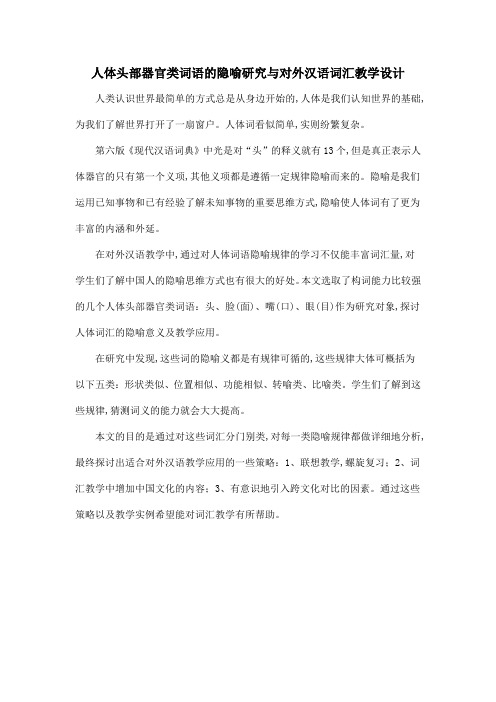
人体头部器官类词语的隐喻研究与对外汉语词汇教学设计
人类认识世界最简单的方式总是从身边开始的,人体是我们认知世界的基础,为我们了解世界打开了一扇窗户。
人体词看似简单,实则纷繁复杂。
第六版《现代汉语词典》中光是对“头”的释义就有13个,但是真正表示人体器官的只有第一个义项,其他义项都是遵循一定规律隐喻而来的。
隐喻是我们运用已知事物和已有经验了解未知事物的重要思维方式,隐喻使人体词有了更为丰富的内涵和外延。
在对外汉语教学中,通过对人体词语隐喻规律的学习不仅能丰富词汇量,对学生们了解中国人的隐喻思维方式也有很大的好处。
本文选取了构词能力比较强的几个人体头部器官类词语:头、脸(面)、嘴(口)、眼(目)作为研究对象,探讨人体词汇的隐喻意义及教学应用。
在研究中发现,这些词的隐喻义都是有规律可循的,这些规律大体可概括为以下五类:形状类似、位置相似、功能相似、转喻类、比喻类。
学生们了解到这些规律,猜测词义的能力就会大大提高。
本文的目的是通过对这些词汇分门别类,对每一类隐喻规律都做详细地分析,最终探讨出适合对外汉语教学应用的一些策略:1、联想教学,螺旋复习;2、词汇教学中增加中国文化的内容;3、有意识地引入跨文化对比的因素。
通过这些策略以及教学实例希望能对词汇教学有所帮助。
隐喻转喻视角下的英语人体词汇多义现象阐释

- 208 -校园英语 /语言文化隐喻转喻视角下的英语人体词汇多义现象阐释重庆医科大学外国语学院/杨小波【摘要】本文以实例探讨了隐喻和转喻两种认知机制在人体词多义生成中的机制,并指出在词汇学习中引入认知机制的学习将就将对词汇学习大有裨益。
【关键词】隐喻 转喻 多义 人体词一、引言一词多义现象是人类语言中极为普遍的现象。
Lyons 认为“人类所有的语言都没有,也不曾有过一个词有且只有一个意义的时候”。
一词多义是所有语言共有的特点,这种现象一直都是语言者们关注和研)究的重点和焦点。
以结构主义语言学为代表的传统方法侧重于关注词语本身的内部逻辑关系。
二十世纪七十年代兴起的认知语言学从认知的视角出发,为一词多义现象提供了更科学、更系统的解释。
认知语言学认为一词多义现象是建立在体验主义哲学基础上,隐喻和转喻是多义词从基本意义向相关意义延伸的主要方式。
二、隐喻和转喻1.隐喻是由源域到目的域的基本结构或部分结构的映射过程,它的实质是以一件事或经验来理解和经历另一件事或经验。
在日常生活中,人们往往参照他们熟知的、有形的、具体的概念来认识和理解陌生的、无形的、抽象的概念。
以Life is a journey 为例,人们利用旅行和人生两者在心理认知上的相似性,把“旅行域”映射到“生活域”通过具体的概念“旅行”来理解抽象概念“人生”。
2.转喻。
转喻涉及一种“接近”和“突显”的关系,是用相近或相关联的不同概念域中的一个突显的事物来代替另一事物。
接近原则的心理机制是距离相近的事物容易被看作是一个单位,而突显原则认为人们的注意力更容易观察和记忆事物比较突显的方面(赵艳芳:2001)。
如 We need more hands here ,手是身体的一部分,用手代替人力,属于部分代替整体的转喻。
三、人体词多义的认知阐释人类的认知总是遵循这样一些规律:以自我为中心,由近及远、由浅入深、由具体到抽象、由已知到未知、由自我到非自我。
人们最先认识的是自己,再将对自己身体的认识以各种方式映射到客观世界,通过隐喻或转喻把已形成的熟悉的、具体的、易理解的体系投射到陌生的、抽象的、复杂的体系,从而逐步的认识世界。
图形—背景理论看与人体身体部位相关的转喻

图形—背景理论看与人体身体部位相关的转喻摘要:认知语言学认为,人们与外部客观世界的互动多以已有身体经验为基础和参照,进而不断与外部客观世界建立相互联系。
转喻作为人体重要的认知方式,在与客观世界进行互动时起着举足轻重的作用。
在认知语言学框架下,用图形—背景理论对人体身体部位相关词进行转喻分析,拟加深人们对转喻运作机制和人体身体部位词转喻义的理解,为人体身体部位词的认知研究提供启示。
关键词:转喻;图形—背景理论;人体身体部位一、引言认知语言学是以体验哲学为基础的,即人们多以自身身体经验为基础和参照来对外部客观世界进行认知。
人是认知外部客观世界的主体,身体部位是人体的重要组成部分,在与客观世界互动时扮演着十分重要的角色,相应地,对身体部位词转喻义及其作用机制的研究将加深人们对语言形式和语言意义关系的理解。
人类在对客观世界或某一客体进行认知时,常根据事物所具有的凸显特征,在头脑中自主对认知客体或客观世界进行图形和背景的分离,在特定的认知语境下,凸显性较强的部位便为图形。
1978年Talmy把图形与背景理论引入语言学领域,认为图形与背景是语言中最基本的两个认知功能。
本文将以认知语言学中的图形背景理论为基础来对人体身体部分词相关的转喻个例展开探讨分析,结合身体部位词的转喻意义,来探究其在具体的言语表达使用中的图形—背景特征,为身体部位词的认知研究提供启示。
二、图形—背景与转喻认知图形—背景理论体现了认知的凸显性。
同一主体从不同的视角对客体进行认知,客体在脑海中所留的印象与客体各部分的凸显性将存在较为显著的差异,相应地便呈现了图形与背景分离的差异性。
图形和背景相辅相成,对于所认知的客体,凸显性较强的部分是图形,剩余的部位或该事物个体便是背景。
在具体的语言结构表达使用中亦是如此,在言语表达使用中,通过使用词义较为凸显的表达,说话者或听话者能够直接明晰话语交际目的,生动地展现了图形—背景的作用机制。
转喻在人体对外部客观世界进行认知时起着十分重要的作用。
从隐喻和转喻的视角看待人体词“nose”认知语义网络及启示

从隐喻和转喻的视角看待人体词“nose”认知语义网络及启示刘志成【摘要】Polysemy as a very important language phenomenon has important value of research.“Nose”as an important organ of the head has more cognitive advantages concerning its location and feature.In addition,human body terms are the cognitive meta-concepts and the cognitive starting point for the world, so the study of polysemy of the typical human body term is not only beneficial to reveal the basic laws and the cognitive mechanism of semantic extension,but also beneficial to reveal the thinking modes and cog-nitive characteristics of the cognitive subjects.Moreover,metaphor and metonymy have long been consid-ered as two rhetorical means,and this paper carried on the new exploration of metaphor and metonymy from the perspective of cognition,and pointed out that metaphor and metonymy are not only important thinking modes and cognitive means,but also the cognitive mechanism of polysemy.Based on the seman-tic web of polysemy,this paper reveals that the semantic extension is not arbitrary,and metaphor and metonymy are interweaved in the process of semantic extension,which further confirms that language is not an autonomous,closed system,and in this way dismisses to a certain degree the Saussure’s language“arbitrary”point of view.%一词多义是语言中非常重要的语言现象,具有重要的研究价值。
英汉语言中“眼”的隐喻与转喻意义的对比考察

英汉语言中“眼”的隐喻与转喻意义的对比考察隐喻和转喻是人类重要的认知模式,对身体词的各种活用又是隐喻和转喻的突出体现。
本文从隐喻和转喻的概念入手,从隐喻和转喻的定义出发,通过比较两者的区别,分析英语和汉语这两种语料,以此来探索“眼”的隐喻和转喻意义标签:眼转喻隐喻英汉对比一、引言认知语言学认为,概念隐喻和转喻意义系统是基于感知体验,而感知体验又是基于人的身体构造。
由此可见,人的身体及其感觉在隐喻意义形成和概念化的过程中起到了至关重要的作用。
“眼”作为视觉器官,是人身体感觉中最为重要的一部分,可以有各种不同的隐喻和转喻意义。
本文试从认知语言学的角度出发,结合隐喻和转喻的定义及两者的比较,系统探讨英汉这两种语言中“眼”的隐喻和转喻意义。
具体考察其个性和个性及其背后的构词理据。
本文采用的语料主要有两种:北京大学汉语语言学研究中心的现代汉语语料库;British National Corpus。
George Lakoff认为,隐喻的认知基础是“意象图式”,意象图式来源于我们的日常生活。
与隐喻相同,转喻也是基于人们的基本经验,其实质是概念性的,是自发的、无意识的认知过程,是丰富语言的重要手段。
然而,人类的身体是认知的主体,身体与外部世界的互动过程中所获得的体验是人类认识客观世界的基础。
维柯指出:“在一切语言里,大部分涉及无生命事物的表现形式,都是从人体以及人的感觉和情欲那里借来的隐喻。
”同样,通过对身体词的转喻,语言得到了极大的丰富。
例如,杯子可以有“口”,凳子可以有“脚”,茶壶可以有“嘴”,“国脚”代替著名足球运动员。
“眼睛”作为心灵的窗户,在人体部位中占据着重要的地位,有着至关重要的作用。
在汉语和英语中发现有很多“眼”的隐喻和转喻表达式。
下面就从隐喻和转喻的定义出发,通过比较两者的区别,分析英语和汉语这两种语料,以此来探索“眼”的隐喻和转喻意义。
二、隐喻与转喻的比较隐喻是从始源域到目标域的概念化映射。
从隐喻的角度看人体器官词
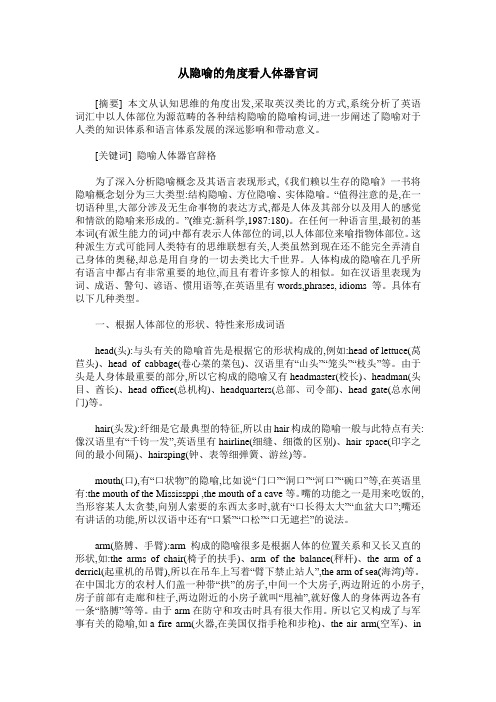
从隐喻的角度看人体器官词[摘要] 本文从认知思维的角度出发,采取英汉类比的方式,系统分析了英语词汇中以人体部位为源范畴的各种结构隐喻的隐喻构词,进一步阐述了隐喻对于人类的知识体系和语言体系发展的深远影响和带动意义。
[关键词] 隐喻人体器官辞格为了深入分析隐喻概念及其语言表现形式,《我们赖以生存的隐喻》一书将隐喻概念划分为三大类型:结构隐喻、方位隐喻、实体隐喻。
“值得注意的是,在一切语种里,大部分涉及无生命事物的表达方式,都是人体及其部分以及用人的感觉和情欲的隐喻来形成的。
”(维克:新科学,1987:180)。
在任何一种语言里,最初的基本词(有派生能力的词)中都有表示人体部位的词,以人体部位来喻指物体部位。
这种派生方式可能同人类特有的思维联想有关,人类虽然到现在还不能完全弄清自己身体的奥秘,却总是用自身的一切去类比大千世界。
人体构成的隐喻在几乎所有语言中都占有非常重要的地位,而且有着许多惊人的相似。
如在汉语里表现为词、成语、警句、谚语、惯用语等,在英语里有words,phrases, idioms 等。
具体有以下几种类型。
一、根据人体部位的形状、特性来形成词语head(头):与头有关的隐喻首先是根据它的形状构成的,例如:head of lettuce(莴苣头)、head of cabbage(卷心菜的菜包)、汉语里有“山头”“笼头”“枝头”等。
由于头是人身体最重要的部分,所以它构成的隐喻又有headmaster(校长)、headman(头目、酋长)、head office(总机构)、headquarters(总部、司令部)、head gate(总水闸门)等。
hair(头发):纤细是它最典型的特征,所以由hair构成的隐喻一般与此特点有关:像汉语里有“千钧一发”,英语里有hairline(细缝、细微的区别)、hair space(印字之间的最小间隔)、hairsping(钟、表等细弹簧、游丝)等。
mouth(口),有“口状物”的隐喻,比如说“门口”“洞口”“河口”“碗口”等,在英语里有:the mouth of the Mississppi ,the mouth of a cave等。
认知视角下人体部位词的隐喻研究
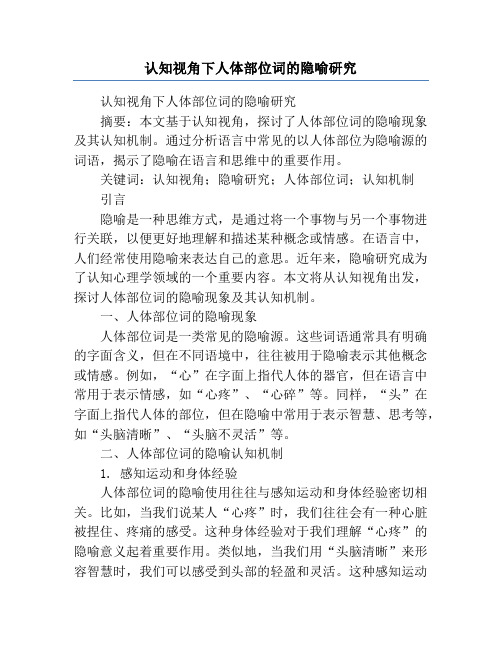
认知视角下人体部位词的隐喻研究认知视角下人体部位词的隐喻研究摘要:本文基于认知视角,探讨了人体部位词的隐喻现象及其认知机制。
通过分析语言中常见的以人体部位为隐喻源的词语,揭示了隐喻在语言和思维中的重要作用。
关键词:认知视角;隐喻研究;人体部位词;认知机制引言隐喻是一种思维方式,是通过将一个事物与另一个事物进行关联,以便更好地理解和描述某种概念或情感。
在语言中,人们经常使用隐喻来表达自己的意思。
近年来,隐喻研究成为了认知心理学领域的一个重要内容。
本文将从认知视角出发,探讨人体部位词的隐喻现象及其认知机制。
一、人体部位词的隐喻现象人体部位词是一类常见的隐喻源。
这些词语通常具有明确的字面含义,但在不同语境中,往往被用于隐喻表示其他概念或情感。
例如,“心”在字面上指代人体的器官,但在语言中常用于表示情感,如“心疼”、“心碎”等。
同样,“头”在字面上指代人体的部位,但在隐喻中常用于表示智慧、思考等,如“头脑清晰”、“头脑不灵活”等。
二、人体部位词的隐喻认知机制1. 感知运动和身体经验人体部位词的隐喻使用往往与感知运动和身体经验密切相关。
比如,当我们说某人“心疼”时,我们往往会有一种心脏被捏住、疼痛的感受。
这种身体经验对于我们理解“心疼”的隐喻意义起着重要作用。
类似地,当我们用“头脑清晰”来形容智慧时,我们可以感受到头部的轻盈和灵活。
这种感知运动和身体经验帮助我们将人体部位词与其他概念或情感进行关联。
2. 回忆和经验积累隐喻往往依赖于个体的回忆和经验积累。
人们通过长时间的语言和文化传承,将某些人体部位与特定概念或情感关联起来。
这些关联会在个体的语言运用和思维过程中产生影响。
例如,“手”经常被用于表示援助和帮助,这可能与我们在婴儿时期接受到的依赖和帮助有关。
这种回忆和经验积累为我们理解和使用人体部位词的隐喻意义提供了基础。
3. 集体文化价值观隐喻现象不仅与个体的经验和认知有关,也与集体的文化价值观密切相关。
不同文化对于人体部位词隐喻的使用和理解可能存在差异。
汉越人体名词隐喻对比研究

汉越人体名词隐喻对比研究【摘要】:人体词语是人类语言的基本词汇之一,而人体隐喻也是人类最为普遍的思维方式之一。
人类认识世界是从自身开始的,并以自身作为衡量世界的标准。
从这个意义上可以说,人类语言的发展,都是从“自身”开始的。
人类把对人自身的认知类推到外部世界事物上,外部世界以拟人化的命名或描述。
反过来,人类也把对外部世界的认知类推到人的自身,用外界事物给人体部位和器官命名或加以描述。
这些人体隐喻及其成果是人体隐喻最为基本的类型。
人类的认知活动来源于身体经验。
一方面,不同民族的身体经验可以是相同的,所以,我们可以假设人体隐喻概念系统是有普遍性的,而另一方面,文化背景的差异会影响人们的认知体验,因此我们又有理由推论,不同文化的人体隐喻概念系统中存在着差异。
问题是,不同的语言文化究竟在多大程度上表现出人体隐喻概念系统的异和同,本文拟通过对汉、越两种语言的人体名词各方面对比来试图回答这个问题。
在综合运用词汇学、语义学、认知语言学、心理学等相关学科的理论和研究成果的基础上,本研究主要采用对比研究方法、描写与解释结合法、定性和定量结合法,对人体名词进行多角度、多层次探讨。
除结语外,全文共分六章。
第一章绪论本章介绍了人体隐喻在人类语言中的普遍存在。
人类的思维具有“体认”(embodied)的特征,即人体及其器官是人类认知活动的基础和出发点之一,人类倾向于将对人体自身的认知结果投射到对其它物体的认知与理解中去。
正如古希腊哲学家Protagoras(前485—前410)的著名格言所云:”Manisthemeasureofallthings”(人是万物的尺度)。
因此,在各种语言中都很容易发现用人体及其部位作为衡量世界的标准而映射到其他事物,不管是抽象的还是具体事物都是如此。
对此,国外的众多研究主要从几个方面进行探讨,如:从语义的角度研究人体词语;从文化视角研究人体词语;从认知角度研究人体词语;从人类学视角研究人体词语,等等。
转喻机制下的人体部位词一词多义现象

科 技 视 界
科技・ 探索・ 争鸣
转喻机制下的人体部位词一词多义现象
黄秀 娟 陈 婷婷 ( 安庆师 范 学 院 外 国语 学 院 , 安徽 安庆 2 4 6 0 0 0 )
【 摘 要】 一词多义是一种重要 的语 言现 象, 其主要通过 隐d ‘ 头” 和“ m o n t h ‘ 1 2 " 、 嘴” 为语料 . 从认
一
0 引言
mo u t h” 。
隐喻 和转喻是修辞手段 . 也是认知方式 多义化与人类 的转喻和 隐喻性思维有着 内在 的必然关 系。 L a k o f ( 1 9 8 7 : 1 3 ) 指出“ 一词 多义起 源 于不 同认知域 以及 同一认知域 中不 同元索之 间的关系 ” 儿童语 言习 得研究表 明. 儿童过度地扩展 已知词汇的词义主要是通过转喻 和隐喻 思维完成 的 转喻和隐喻思维是多义化的主要认知途径 . 多义词词 义 间 的理据性是通过转喻和隐喻思维扩展词义的必然结果 隐喻是由源 域到 目的域 的基 本结 构或部分结构 的映射过程 , 隐喻作为一种认知方 式 .其核心在于我们必须依赖 已知晓和懂得 的概念及语言表达方式 . 由此及彼 . 由表及 里 . 有时还要 发挥惊人 的联想 力和创造 力把熟悉 和 不熟悉 的事物做 不同寻常的并列 ( 胡壮麟 , 2 0 0 4 : 3 ) , 比如 . 脸是五官 的 衬底 . 也是人体的核心部位之一 , 因此 具有“ 前面” 、 “ 表面” 、 “ 重要 的方 面” 等属性。 由此 , “ 脸、 面” 就可 以用来指代物体 的表面 、 前面或事物 的 外表。如英语 中的“ 门脸 ” . “ 鞋脸 ” 。 英语 中“ t h e f a c e o f t h e b u i l d i n g ” 枣 筑物的前 面) . “ t h e f a c e 0 f a c a r d ” ( 牌 的正面) , “ t h e f a c e o f a n o t e ” ( 票面) 等。L a e k o f 指 出: “ 转喻是认知 的基本特征之一 , 人们常用易于理解和 感 知的事 物的一个 方面指代整个事物或事物 的另一个方 面。” 转喻所 涉及 的是一种“ 接近 ” 和“ 突显” 的关系 ( 赵艳芳 . 2 0 1 1 : 1 1 5 ) 转喻中的本 体 和喻体之间的映射在 同一个域 中进 行 .本体和 喻体是一种 替代关 系. 即通过事物的突显特征来 辨认该事物 . 事物与事 物之 间具有 邻近 性关 系特征 ( 李瑛等 : 2 0 0 6 : 2 ) G o o s s e n s ( 2 0 0 2 ) 在研究人体部位词 汇用法 的时候对 转喻和隐喻 的关系做 了如下总结 : 隐喻来源 于转喻 . 隐喻中 有转喻 : 转喻 中有隐喻 . 隐喻语境 中非转喻化 ( 即转喻 的消失 ) 。
阿拉伯语人体词“眼”一词多义的隐喻和转喻认知研究
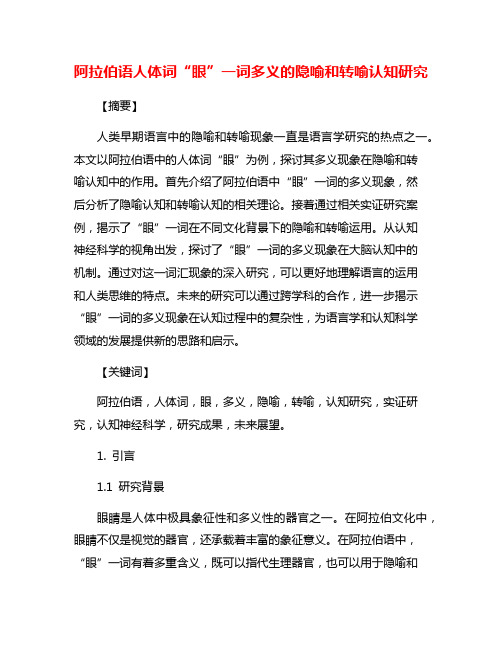
阿拉伯语人体词“眼”一词多义的隐喻和转喻认知研究【摘要】人类早期语言中的隐喻和转喻现象一直是语言学研究的热点之一。
本文以阿拉伯语中的人体词“眼”为例,探讨其多义现象在隐喻和转喻认知中的作用。
首先介绍了阿拉伯语中“眼”一词的多义现象,然后分析了隐喻认知和转喻认知的相关理论。
接着通过相关实证研究案例,揭示了“眼”一词在不同文化背景下的隐喻和转喻运用。
从认知神经科学的视角出发,探讨了“眼”一词的多义现象在大脑认知中的机制。
通过对这一词汇现象的深入研究,可以更好地理解语言的运用和人类思维的特点。
未来的研究可以通过跨学科的合作,进一步揭示“眼”一词的多义现象在认知过程中的复杂性,为语言学和认知科学领域的发展提供新的思路和启示。
【关键词】阿拉伯语,人体词,眼,多义,隐喻,转喻,认知研究,实证研究,认知神经科学,研究成果,未来展望。
1. 引言1.1 研究背景眼睛是人体中极具象征性和多义性的器官之一。
在阿拉伯文化中,眼睛不仅是视觉的器官,还承载着丰富的象征意义。
在阿拉伯语中,“眼”一词有着多重含义,既可以指代生理器官,也可以用于隐喻和转喻表达。
这种多义现象在语言和文化交流中起着重要作用,影响着人们的认知和交流方式。
随着现代社会的发展,人们对语言和文化的探究愈发深入。
研究阿拉伯语中“眼”一词的多义现象及其隐喻和转喻认知具有重要的理论和实践意义。
通过对这一词汇的深入分析,可以深化对阿拉伯语言和文化的理解,拓展跨文化交流的视野,促进语言学、文化学和认知科学等领域的交叉研究,为跨文化交流和沟通策略的制定提供理论支持。
1.2 研究意义眼睛作为人体器官之一,在人类文化中一直扮演着重要角色。
阿拉伯语中的“眼”一词有着丰富的多义现象,既可以指代生理上的眼睛,也可以用作隐喻和转喻的象征。
通过对阿拉伯语中“眼”一词的多义现象进行研究,可以帮助我们更深入地理解阿拉伯文化中的意象和象征,探讨其深层含义。
隐喻和转喻作为语言中常见的修辞手法,可以丰富语言的表现力和内涵。
汉语人体部位特征的隐喻研究

汉●语●人●体●部●位●特●征●的●隐●喻●研●究● ○程淑贞一汉语中有很多以人体部位名称指称事物、阐明事理的语汇,它们以各种不同的表达形式出现,或词,或成语,或警句、民谚、格言、惯用语等,而且从头到脚,从衣饰到行为动作,几乎无所不包。
大致罗列一下,基本有下面几类:(一)以人体不同部位的名称为语素,采用拟人方式构成事物的概念名称。
如:山头 枝头 首都 山顶 树顶 龙头 针眼 炮眼 泉眼 枪眼壶嘴 壶肚 壶口 喷嘴 窗口 路口 山口 风口 谷口 门口锯齿 轮齿 书眉 火舌 帽舌 项目 水喉 车身 河身 圆心中心 鼎足 山腰 山脚 山腹 山脊 山脉 瓶颈 瓶口 瓶腹针鼻儿 门鼻儿(二)以人体部位名称或与人体有密切关系的衣服饰物等名称,通过借代、比喻、比拟等方式形成词语,以喻指事物或概念。
如:头脑、头目、头颅、首领———喻指集团或部门的负责人;耳目、眼目———喻指替人刺探消息的人;辫子———指人的把柄;首尾———指事情的起末;手足———喻指兄弟姐妹;骨肉———指父母兄弟子女等亲人;骨血、后裔———指后代;骨干———喻指总体中起主要作用的人或事物;头角———喻指青年的才华、气概;皓首———代指老年人;手脚———指暗中作弊;心腹———喻指人的亲信;手臂———喻指人的助手;手腕———喻指人的本领或能耐;眼珠子———喻最珍爱的人或物;咽喉———喻指人的本领或能耐;眼珠子———喻最珍爱的人或物;咽喉———喻指形势险要的交通孔道;心脏———比喻中心位置;头面———旧时喻指妇女头上饰物的总称;股肱———喻指国家重臣;蛾眉———指女子;须眉———指男子;布衣———代指平民百姓;裙衩、巾帼———代指妇女;便衣———代指穿便装执行公务的军人、警察等;连襟———喻指姐妹们的丈夫之间的亲属关系;粉黛———喻指妇女;缙绅———旧指有官职或做过官的人;乌纱帽———喻指官员。
(三)以人体部位的特征、状态,或行为动作等来描述事物、比喻事理。
人体名称妙喻

咽喉(比喻形势险要的交通孔道,如“咽喉要道”。) 骨肉(指亲人,如“骨肉团聚”。) 舌根(比喻闲话) 臂膀(比喻得力助手,如“左膀右臂”。)
心肝(指良心;还用来称呼自己最心爱的人。)
心腹(指最亲近信任的人)
口齿(表示一个人的口才) 胃口(食欲或食量;比喻对事物或活动的兴趣。)
耳目(比喻替人刺探消息的人) 肝胆(比喻真诚的心、勇气,如“肝胆相照”。) 腰杆(比喻脏、骨头、手足……这是我
们身体上的器官。你知道吗,这些人
体名称有着它们巧妙的比喻义。恰当 地运用它们,能使意思表达得形象而
生动。人体名称都各有什么妙喻呢?
头脑:一是用作“头绪”,如“摸不着头脑”;一是比作 首领。
手心(比喻所控制的范围,如“他逃不出我的手心”。) 手腕(手段,本领、能耐) 手足(比喻兄弟,如“情同手足”。)
眉目(条理头绪或事情的线索) 须眉(指男子) 眉睫(比喻事情紧迫,如“迫在眉睫”)
骨头(比喻人的品质、气概) 骨架(比喻物体内部用于支撑的架子。
如“工地上耸立着楼房的骨架”。)
骨干(比喻在集体中起主要作用的人。)
心脏(比喻中心,如“首都北京是祖国的心脏”。) 心肠(对某事物的感情) 心尖儿(父母用来称赞自己最喜爱的儿女。) 心胸(指一个人的气量) 心血(指人的精力)
《尤利西斯》里的身体隐喻以“眼睛隐喻”为例

2020年12月第28卷第4期西安外国语大学学报Journal of X i' an International Studies UniversityDec. 2020Vol. 28. No. 4《尤利西斯》里的身体隐喻:以“眼睛隐喻”为例吴显友(重庆师范大学外国语学院重庆401331)摘要:本文基于认知隐喻理论视角,运用统计分析方法和文本阐释法对《尤利西斯》里部分人体官能词,如眼睛、头部、手、嘴巴等进行了统计与分析,随后以“眼睛”为个案研究对象,总结、归纳了《尤利西斯》里有关“眼睛”的五类隐喻类型,如“眼睛是情感容器、视线是捉摸/眼睛是肢体、眼睛是发光物体、眼睛是(像)其他物体”,并结合文本的具体语 境研究其结构、功能及认知语义,揭示隐喻的系统性和认知肌理,对正确认识和把握乔伊斯隐喻思想、语言观以及身体 叙事学也有积极意义3关键词:《尤利西斯》;身体隐喻;眼睛隐喻;认知语义;身体叙事学中图分类号:1562.074文献标识码:A文章编号:1673-9876(2020)04-0102-06A b s tr a c t:A r m e d with the theory of cognitive metaphor, by m e a n s of statistic analysis a n d text analysis, this paper first m a k e s a statistic analysis of the frequency of s o m e bod y organs, such as eyes, head, h a n d,m o u t h,etc. ,a n d then, as a case study of **eyesM in Ulysses,s u m m a r i z e s a n d discusses s o m e five types of cognitive metaphors of ^e y e s" ,suc h as T H E E Y E S A R E C O N T A I N E R S F O R T H E E M O T I O N S,S E E I N G IS T O U C H I N G/E Y E S A R E L I MB S,T H E E Y E S A R E G L O W I N G O B J EC T S,T H E E Y E S A R E O T H E R O B J E C T S,a n d lastly explores their cognitive structures, functions a n d implications in their specific contexts,so as to demonstrate the systematicness a n d m e c h a n i s m s of cognitive metaphor, wh i c h is conducive to understanding Joyce *s metaphorical m i n d,philosophy of language a n d narratology of the body.K ey w o r d s:Ulysses;b ody m e t a p h o r s;metaphors of ^eyes*' ;cognitive m e a n i n g s;narratology of the bodyi.引言1921年9月21日,乔伊斯在用意大利语写给好友 利内蒂的信中透漏了《尤利西斯》的创作主题和技巧:“这是两个种族(以色列与爱尔兰)的史诗,同时,不仅是 一天(一生)的小故事,也是人体的循环。
- 1、下载文档前请自行甄别文档内容的完整性,平台不提供额外的编辑、内容补充、找答案等附加服务。
- 2、"仅部分预览"的文档,不可在线预览部分如存在完整性等问题,可反馈申请退款(可完整预览的文档不适用该条件!)。
- 3、如文档侵犯您的权益,请联系客服反馈,我们会尽快为您处理(人工客服工作时间:9:00-18:30)。
人体器官名词的隐喻与转喻研究人是社会的核心,语言是社会的产物,因此在汉语中存在着大量与人体有关的词语。
今天,这些词语已不再单单指称人体器官,而是被赋予了新的意义。
本文从认知语言学的角度,对人体器官名词的语义从隐喻和转喻两方面进行了分析,进一步说明了人体词语隐喻和转喻的系统性及形成。
标签:人体器官名词隐喻转喻机制系统为了满足人类交流的需要,语言应运而生。
人体词语作为名词与汉语里普通名词一样具有语义的共时性和历时性、多义性和文化性,除此之外,人体词语还具有隐喻性和转喻性两个个性语义特征。
其中,人体词语的隐喻性包括对外界事物整体的隐喻和对人体部位的部分隐喻两个方面;人体词语的转喻性包括人体词语转指人、转指长度单位、转指人体相应部位的特征或功能、转指人体部位相应的动作行为四个方面。
一、人体词语与普通名词的共性语义特征(一)客观性语义的内容来源于客观世界中客观存在的事物,所以语义是客观的。
正是因为世界上客观存在“山、人、狗”等事物或现象,人们才有可能通过认识形成相应的概念从而创造出表现这些概念的音义结合词来。
“头”这个词之所以“是人体的最上部分或动物的最前部分,长着口、鼻、眼等器官”,是由“头”这个器官的特点决定的。
古代典籍中没有“人造卫星”“电脑”这些词,因为这些事物在古代不是客观存在的。
(二)历时变化性语义的历时变化由两方面原因形成。
一方面源于客观世界的发展变化,词义以客观世界为内容,客观世界的变化必然引起语义的变化。
《汉语大词典》列出的“心”的15个义项中有14个义项呈现出从具体到抽象的演变过程。
前三个义项为具体的器官实物义项——“心脏:人和脊椎动物体内血液循环的肌性器官”“心脏所在的部位泛指胸部”和“胃部”。
另外有三个义项体现了从实物义到非实物义之间的过渡:“木上的尖刺、花蕊或草木的芽尖等”“某些点心的馅子,如包子心、饺子心”“中心,中央”。
这是人们由心脏在人体所处的位置而联想到外界处于中心位置的具体事物。
或者进一步舍弃具体事物而仅提取中心位置这一特征,将这个特征的意义赋予“心”,如“中心,中央”义。
剩下的8个义项为抽象的义项。
(三)共时多义性由于各种原因词义在历时变化的过程中,也会丧失有些义项。
如“脚”的本义为“下腿”,这一义项早在先秦就已存在,先秦时“脚”还可以用于指称“整个下肢”。
”脚”的“足”义在汉末出现,在晋代成熟(董志翘,1985),唐代以后“脚”在基本词汇中已代替“足”,现代汉语中,“脚”指“下腿”或“下肢”的本义已经消亡,“脚”专指“足”,即“接触地面、支持身体和行走的部分”。
(四)文化性语言是和文化密切相关的,语言词汇反映它所服务的文化。
人体词语寄托了古人对自身状况的认识,词义反映了深厚的民族文化内涵。
不同民族的人、不同的地理位置、不同的生活体验、不同的文化习俗使得不同语言中的人体词语产生了一些独特的派生义。
如许多西方人的鼻子向前凸出,这个特征引起了他们的注意,并引发了他们的有关联想,从而赋予其特有的意义,指“形状和位置似鼻子的东西(如飞机的机首、轮船的船头、汽车的前端、冲浪板的前部、甚至乌龟壳隆起的背部等)。
受传统文化的影响,汉民族讲究仁义道德,为人做事遵章守循,礼让三分。
于是“体”便有了“体统;体制”义。
二、人体词语词义的隐喻系统性这里所说的隐喻系统性有别于Lakoff&Johnson(1980)的隐喻系统性。
后者指某一领域的相关概念和结构被整体转移到另一领域,从而使隐喻具有系统性。
本文所说的隐喻系统性指人将自身各部位的认识投射到周围事物上,建立由各个隐喻概念构成的相互联系的隐喻系统。
依照这个概念我们将人体词语的隐喻粗略地分为两类:(一)从人体自身某一部位出发,根据它的形貌或位置、功能等特征来认知周围的事物。
即将社会生活中与我们身体的某一部位存在形貌、位置或功能等相似的客观事物与我们的身体部位进行类比投射,于是便出现了以某一特定身体部位为核心构建的一系列隐喻。
如“脚”的位置特征是在身体的最下部,所以在我们认知外界事物时,用“脚”去隐喻地指称事物最下端的部分。
如“墙脚、山脚、箭脚、地脚、韵脚、注脚、鬓脚、根脚、裤脚、秧脚、雨脚、床脚、泔脚”等。
又如“口”具有中间空的形状特征,又有出入通道的功能,所以在认知的过程中用“口”指称世界中具有这两项特征的客观事物,形成一个关于“口”的隐喻系统。
如“领口、杯口、瓶口、袖口、管口、炮口、坛口、枪口、山口、洞口、港口、海口、巷口、河口、胡同口、鞋口、断口、缺口”等。
(二)对事物整体的系统隐喻即以客观事物为目标域,以人体为本源域,将人体各部位的生理特征对应的概念通过隐喻投射给其它事物,使其“整体人化”的一种隐喻。
如“山”在中国被看成一个“具有一系列人体部位的人”,因为“山”有“山头、山口、山腰、山脊、山身、山脉、山脚”,甚至还有“山心、山额、山肋、山骨、山肤、山眼、山腹、山颜、山趾”等。
整体的系统隐喻分布很广,包括自然景观(海、山、树、河、江、菜)、日常用品(壶、瓶、炉、灯、钉、锁、针、扇、床、笔)、鞋帽服饰(裤、帽、鞋、被)、交通设施(路、桥、车、船)、建筑居所(墙、屋)、劳动器具与武器(刀、箭、机、犁)、时空(年、月)等众多义类领域(马清华,2000)。
三、人体词语词义的转喻性转喻与隐喻大致相同,转喻也是将始源域的经验投射到目标域,帮助理解目标域的认知机制。
根据Ungerer&Schmid(1996:128)的观点,隐喻可定义为跨不同认知域的映射现象,转喻为同一认知域内跨不同概念范畴的映射现象。
我们可以简单地理解为:隐喻重在“喻”,突出表现的是“相似”的关系;转喻重在“代”,突出表现的是一种“接近”和“突显”的关系。
Lakoff(1987:77)认为在转喻中,事物容易理解或容易被感知的属性或方面被用来代替事物的整体或事物的另外某一方面或部分。
如一个人的鼻子在他的外貌特征中最显眼、最突出,他可能就会被很多人叫做“大鼻子”。
下面我们将探讨人体词语转喻的几种情况:(一)人体器官词语转指人的整体人体部位与人的主体是密不可分的,也是人体不可或缺的一部分,用人体部分器官转指整个人,是转喻中部分转喻整体的一种方式。
如船员在船上工作时他们的手是最忙碌的,所以手是最为突出的特征,于是社会便用“水手”来指代“船员”。
又如一位教师说:“我必须尽快回到讲台,几十双眼睛在期待着我”,显然,这里的“眼睛”转指她的“学生”。
很多人体的外显部位都可以转指人的整体,如“头、脸、口、手、耳、脚、齿、舌”等。
(二)人体器官名词转指长度单位在人类的早期社会,人们无法直接计算事物,只能借助自己的肢体作为计数工具。
用来丈量的标准有手、脚、手指、步子、肘、双臂等,“布指知寸,布手知尺,舒肘知寻”(《大戴礼记·王言》),便是如此。
《说文》中也有记录:尺,十寸也。
从手却十分动脉为寸口,十寸为尺。
……周志:寸尺咫寻常仞诸度量皆以人之体为法。
(《尺部》)咫,中妇人手长八寸谓之咫。
(《尺部》)寸,十分也。
人手却一寸动脉谓之寸口。
从又,从一。
(《寸部》)寻,……度人之两臂为寻,八尺也。
(《寸部》)(三)人体器官词语转指人体相应部位的特征或功能即根据人体某个部位的特质转指其功能的方式。
如“舌”能说话,根据这一功能,由本义为“一种人体器官”转指“言语”。
与其具有相同功能的还有“口”“嘴”“唇”“齿”等。
如“口才、口授”;“多嘴、吵嘴、唇舌、唇焦口燥、口齿伶俐”等。
还有一些以功能为强势特征的部位如:“眼”能看、“耳”能听、“鼻”能闻、“手”能创作、“脚”能步行,这些部位的相应词语都能转指这些功能。
如“眼”:“眼光、眼力”;“耳”:“听力”“听觉”;“鼻”:“嗅觉”;“手”:“手艺、技能”;“脚”:“脚步、奔走”等。
内脏各器官内隐,一般情况下,只与人们的情感、情绪、胆识密切相关。
如“肺”“肝”“肠”“胆”很早就有表情感的习惯。
如“肝火”指容易急躁的情绪,类似的有“动肝火”“肝火旺”等;“肝怒”指容易发怒的心理状态;“肝颤”形容非常害怕;“愁肠”指郁结愁闷的心情;“柔肠”指缠绵的情意;“肠断”形容极度的悲痛;“热心肠”指情意深厚等。
“肺腑之言”指发自内心的言语。
(四)人体器官词语转指人体部位相应的动作行为人体词语转指人体部位发出的相应的动作行为,继而由名词转为动词,在语言中是普遍现象,而不是孤立、个别的或临时的现象,人体部位的大部分词语都能转用为动词,从而构成一个较大的人体词语名词动用的系统。
如“首、眼、目、嘴、牙、面、脖、指、背、肘、手”等。
一个显著的现象是,内脏词语一般难以发生名转动的转换。
因为内脏器官在体内,虽然它们在人体内为维持人的生命不断地在运动着,但这些动作或行为因为没能被我们所感知和体验,不能引起我们的关注。
四、结语人体器官名词在人类认知世界的过程中有着重要的基础作用。
本文从一两个侧面论述了人体器官名词的隐喻和转喻,在撰写的过程中不但认识到人体器官名词对人类认知世界的重要意义,同时注意到运用认知语言学可以解释很多传统方法和理论很难解释的语言现象,突破了传统的理论和方法带来的研究局限。
参考文献:[1]赵艳芳.认知语言学概论[M].上海:上海外语教育出版社,2001.[2]董志翘.“脚”有“足”义始于何时[J].中国语文,1985,(5).[3]范淑云.汉语中与人体部位相关语词的隐喻研究[D].南京师范大学硕士学位论文,2002.[4]程东岳.“脸”的隐喻与转喻——基于“脸”的汉英语料对比研究[J].华东交通大学学报,2007,(3).[5]黄凤.人体隐喻的认知研究[D].四川大学硕士学位论文,2006.[6]黄运亭.英汉人体器官名词名转动比较研究[J].华南理工大学学报,1997,(S2).(徐雪婷辽宁大连辽宁师范大学文学院116029)。
